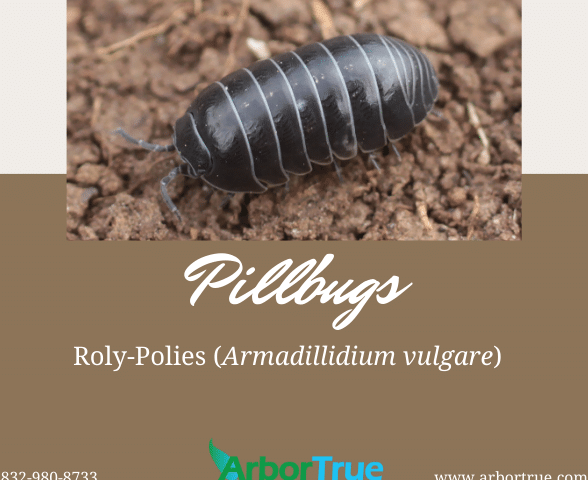
Are Banana Trees, Trees?
July 17, 2024
Mushroom Monday: Peppery Milkcap (Lactarius piperatus)
July 22, 2024
Pillbugs: Roly-Polies (Armadillidium vulgare)
In today’s TrueTreeTalk blog post we explore wonderful little pillbugs. These little crustaceans on land can be beneficial in gardens and are also known as roly-polies because of the way they roll up when bothered. Learn more about them in today’s post.
Their Name
Pillbugs are called pillbugs because when they roll into a ball, they look like a pill. Their scientific name is Armadillidium vulgare and one of their common names is roly-poly.
What are Pillbugs?
Pillbugs are arthropods. They are crustaceans – similar in a way to shrimp, lobsters, or crayfish. They are not insects.
Pillbugs are invertebrates, cold-blooded, and have an exoskeleton.
What do Pillbugs Look Like?
As adults, pillbugs can be gray in color to dark brown in color. They range in size from around a third of an inch to around seven tenths of an inch. They have antennae and antennules on their heads (one pair each) that help them detect things. Their eyes are compound and on the side. Their bodies have two main parts – the thorax and the abdomen, with the thorax being made of segments (seven) each with two legs. Their topsides are convex in shape.
What’s the Lifecycle of a Pillbug?
Pillbugs have three general life stages – eggs, young, and adults.
Females can have eggs between one and three times each year with a variable number of eggs each time. When the eggs hatch, the young pillbugs live in a pouch on the underside of the female’s body for one or more weeks before they leave. After they leave, they molt and gain an additional segment to their bodies (the seventh). They molt again around fourteen days later, at which point they get an additional set of legs (the seventh). After this point, they molt once every seven to fourteen days for a period of around one hundred and twenty six days. The lifespan of an adult can range from 2 to 5 years.
Where do Pillbugs Live?
Pillbugs can be found in Texas and around the world and are common. They live in places such as under leaves, rocks, mulch, and in soil and can be found around other creatures such as earthworms and sowbugs. They come out at night (they are nocturnal) and need higher levels of humidity.
What do Pillbugs Eat?
Pillbugs are detritivores – this means they eat organic matter that has died. This can make them beneficial in a garden as they help to process organic matter and help to improve soil conditions. They sometimes eat roots of plants and seedlings in addition to decaying organic matter.
How do Pillbugs Breathe?
Pillbugs are crustaceans and breathe through gills. Because of this, they need moisture to survive. They can’t live beneath water though. They are sort of the opposite of dolphins. Dolphins live in water but breathe with lungs in the air. Pillbugs live on land but get oxygen through their gills.
Are Pillbugs the Same as Sowbugs?
Pillbugs are not the same as sowbugs (Porcellio laeyis). Both are isopods, however sowbugs are unable to roll up like pillbugs can (because of body parts that extend from their ends). They also have flatter bodies than pillbugs do.
What Eats Pillbugs and How do Pillbugs Defend Themselves?
Pillbugs are eaten by all sorts of things that eat invertebrates, including ants, birds, and amphibians. They defend themselves in a number of ways including hiding and running. Their color helps to camouflage them and their exoskeleton provides some protection. Rolling in a ball (referred to conglobation) can also help to protect them (and also helps them to conserve moisture). Additionally, they have glands that produce substances that are unpleasant to predators.
If you liked learning about pillbugs, check out our other posts on our TrueTreeTalk blog. Follow us on Facebook to keep up with these and other posts.
* * *
ArborTrue is a science-based tree-service company in the greater Houston area. We provide a range of services including tree trimming, tree pruning, tree removal, tree planting, arborist consultations, and more. Call us today at 832-980-8733 or reach out to us online to schedule an appointment.




